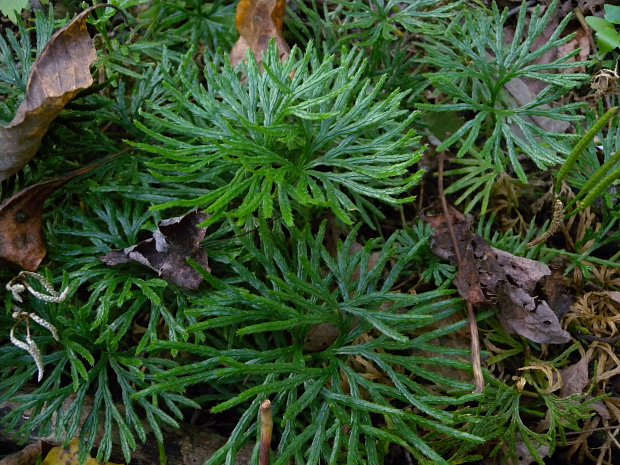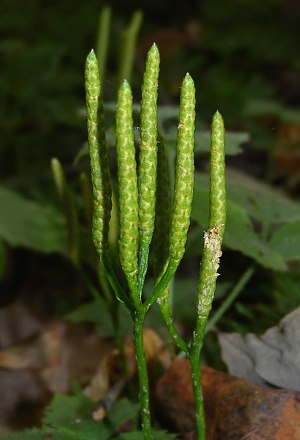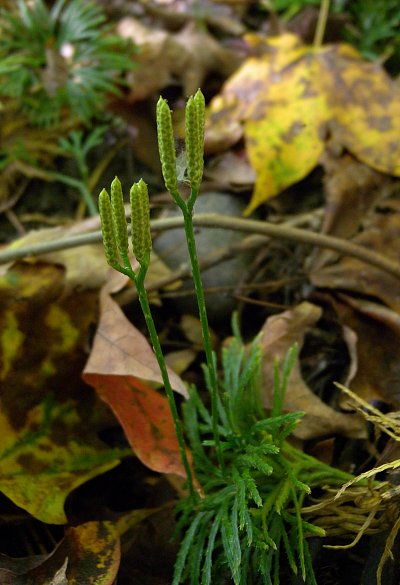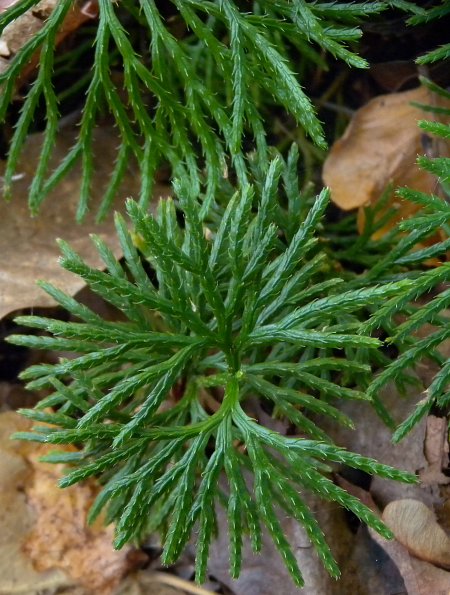Description: This perennial plant produces upright shoots about 3-8" tall (excluding any reproductive structures) from long horizontal stems. The horizontal stems run above the ground in the leaf litter; they branch sparingly (see Horizontal Stem and Young Shoots). The horizontal stems are pale to medium green, terete, and glabrous; distributed sparsely to moderately along their sides, there are tiny scale-like leaves about 3 mm. long that are appressed to slightly spreading. Each upright shoot produces a central stem. The central stem is medium to dark green, terete and glabrous; distributed moderately along its sides, there are tiny scale-like leaves about 3 mm. long that are appressed to slightly spreading. Lateral branches are produced from each stem. The lateral branches are held horizontally to the ground (more or less); they are fan-like in appearance. Usually, these branches divide dichotomously about 3 times. The lateral branches are medium to dark green, glabrous, and somewhat flattened. Along the sides of each lateral branch, there are 4 columnar ranks of scale-like leaves; these leaves are about 3 mm. long and appressed to slightly spreading. The leaves on the two narrow sides of each lateral branch are linear in shape, while the leaves on its two broad sides are lanceolate. Generally, the central stem and lateral branches lack seasonal constrictions.

A fertile upright shoot produces 2 upright peduncles with strobili (cone-like spore-bearing structures). The peduncles are 2-6" long, medium to dark green, terete, and glabrous. Scale-like bracts are sparsely distributed along each peduncle; they are appressed to slightly spreading. At its apex, each peduncle branches dichotomously to produce 1-2 pairs of erect strobili; the branches of each peduncle are up to ½" long, medium to dark dark, terete, and glabrous. Each young strobilus is ¾–1¾" long, light green to yellowish green, glabrous, and narrowly cylindrical in shape. Along the sides of each strobilus, there are appressed to slightly spreading sporophylls (scale-like bracts of the strobili). The sporophylls are about 2 mm. long and deltate-cordate in shape. A single sporangium (spore-bearing structure) is located behind each sporophyll. Eventually, the sporangia split open to release their spores to the wind; this typically happens during the late summer or autumn. Clonal colonies of upright shoots are often produced from the horizontal stems. Fibrous roots are located at intervals along the horizontal stems. The foliage is evergreen.

Cultivation:
Fan
Clubmoss is very difficult to cultivate in the garden. Transplants are
rarely successful, and the development of mature plants from spores is
very slow (taking perhaps 20 years). During its sexual phase, this
species develops underground and requires the presence of appropriate
fungi. It prefers a somewhat acidic soil that is sandy or rocky,
dappled sunlight to light shade, and well-drained conditions.
Range & Habitat:
The native Fan Clubmoss occurs in widely scattered locations throughout
Illinois
(see Distribution
Map). While it is probably the most common clubmoss species
in the state, it is still relatively uncommon. Habitats include upland
woodlands, bluffs, sandstone cliffs, and abandoned sandy fields. Fan
Clubmoss is usually found in wooded areas with oak trees or conifers,
although it also colonizes open sandy areas. This species may be
expanding its range.

Faunal
Associations:
Very little is known about floral-faunal relationships for clubmosses.
Because the foliage contains toxic alkaloids, it is usually avoided by
mammalian herbivores. Colonies of Fan Clubmoss and other large
clubmosses provide nesting habitat for the Nashville Warbler and
probably other ground-nesting songbirds (Harrison, 1979).
Photographic Location:
An upland deciduous woodland at Turkey Run State Park in west-central
Indiana, and an upland deciduous woodland at Walnut Point State Park in
Douglas County, Illinois.

Comments: Fan Clubmoss resembles a dwarf cedar (Juniperus) or another conifer, but it is not closely related to these seed-bearing woody plants. Plants in the Clubmoss family are some of the oldest vascular plants on Earth. During prehistoric times, some members of this family were tree-sized, growing alongside giant horsetails and tree ferns. Some of the these prehistoric plants were eventually transformed into the extensive coal beds that our civilization uses today. Fan Clubmoss can be distinguished from other similar species by considering the following key characteristics: 1) the lateral branches of its upright shoots are fan-like in shape and held horizontally to the ground, 2) there are 4 ranks of scale-like leaves along its lateral branches, 3) its strobili occur in one or two pairs, and 4) its horizontal stems lie on top of the ground surface, rather than underneath it. Older scientific names of this clubmoss are Lycopodium complanatum flabelliforme, Lycopodium flabelliforme, and Lycopodium digitatum. Other common names of this species are Southern Ground-Cedar and Southern Running Pine.